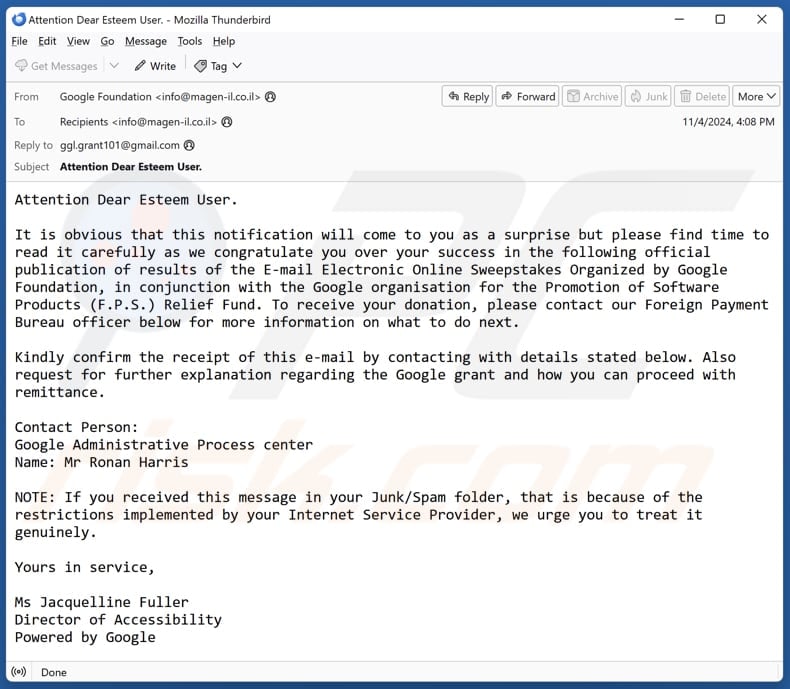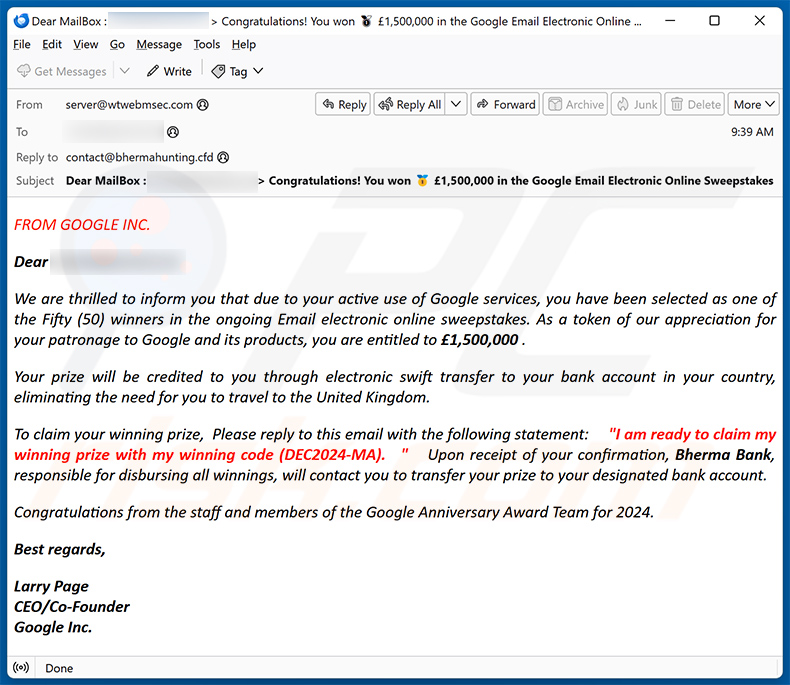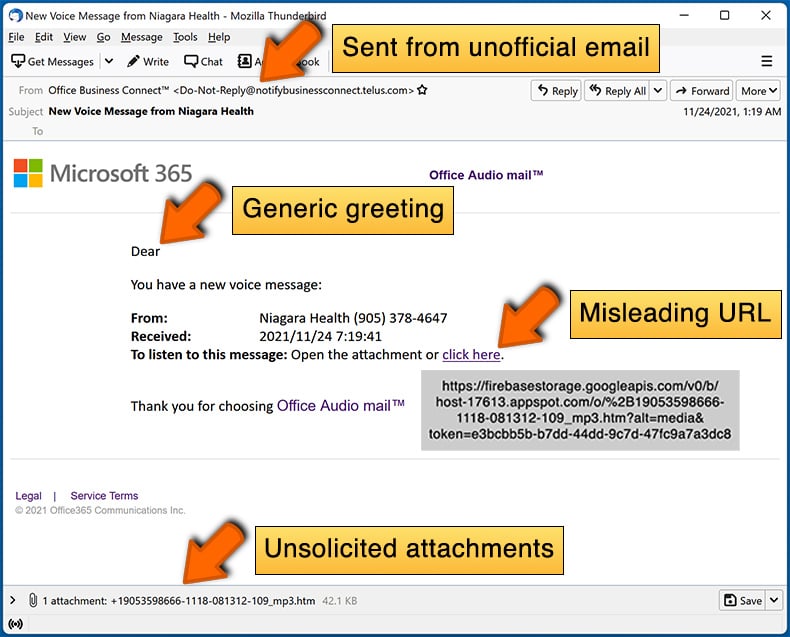How to identify fraudulent emails like "Google Foundation's E-mail Electronic Online Sweepstakes"
Phishing/ScamAlso Known As: Google Foundation's E-mail Electronic Online Sweepstakes bogus notification
Get free scan and check if your device is infected.
Remove it nowTo use full-featured product, you have to purchase a license for Combo Cleaner. Seven days free trial available. Combo Cleaner is owned and operated by RCS LT, the parent company of PCRisk.com.
What is "Google Foundation's E-mail Electronic Online Sweepstakes"?
We have examined this email and learned that it is a fraudulent message, falsely claiming to be from Ms. Jacquelline Fuller, the Director of Accessibility at Google. The scammers behind this email aim to deceive recipients into believing they are eligible for a donation while attempting to steal money and (or) personal information.

More about the "Google Foundation's E-mail Electronic Online Sweepstakes" scam email
This scam email claims that the recipient has won a donation through a Google-sponsored sweepstakes. It urges the recipient to contact a supposed Google representative, Mr. Ronan Harris, for further details on how to receive the donation. The email also mentions that it may appear in the spam folder due to internet provider restrictions.
Typically, emails of this type are created to trick recipients into transferring money to scammers or sending them personal information. In many cases, scammers ask recipients to pay a "processing", "administration", or other fee or provide personal information (e.g., ID card details, credit card information) that can be used for identity theft or other malicious purposes.
Therefore, it is important to be careful when receiving unsolicited emails, especially those that claim you have won a prize or offer unexpected financial rewards. Always verify the sender's authenticity before acting (opening links, files, or disclosing personal details).
| Name | Google Foundation's E-mail Electronic Online Sweepstakes Scam |
| Threat Type | Phishing, Scam, Social Engineering, Fraud |
| Fake Claim | The recipient can claim a donation |
| Disguise | Letter from a Google representative |
| Symptoms | Unauthorized online purchases, changed online account passwords, identity theft, illegal access of the computer. |
| Distribution methods | Deceptive emails, rogue online pop-up ads, search engine poisoning techniques, misspelled domains. |
| Damage | Loss of sensitive private information, monetary loss, identity theft. |
| Malware Removal (Windows) |
To eliminate possible malware infections, scan your computer with legitimate antivirus software. Our security researchers recommend using Combo Cleaner. Download Combo CleanerTo use full-featured product, you have to purchase a license for Combo Cleaner. 7 days free trial available. Combo Cleaner is owned and operated by RCS LT, the parent company of PCRisk.com. |
Similar scam emails in general
Emails of this type are typically scams designed to deceive recipients into sharing personal information or sending money. They often appear urgent, important, or similar messages from legitimate companies or organizations and pressure recipients to act quickly. Recipients should recognize such emails to avoid monetary loss, identity theft, and other issues.
More examples of similar scams are "Budweiser Lottery", "World Bank Group - Overdue Payment", and "Donation To Charity Through You". It is important to mention that deceptive emails can also be used to trick recipients into running malware on computers.
How do spam campaigns infect computers?
Cybercriminals often use email to distribute malware by attaching infected files or links. When recipients open these attachments—such as documents, scripts, archives, or executables—they may inadvertently run malware on their devices. It can occur immediately after opening files or performing additional steps (like enabling macros in infected Microsoft Office documents).
Additionally, harmful links in emails can lead to websites that either prompt users to download malware or do so automatically without their knowledge. In both cases, the objective is to deceive the recipient into infecting computers with malicious software.
How to avoid installation of malware?
Regularly scan your device with reliable security software, and ensure your operating system and applications are up to date. Be cautious with attachments or links from unknown senders, particularly in unexpected or irrelevant emails. Never click on pop-ups, ads, or offers encountered on suspicious websites.
Always download software and files from trusted sources, such as official websites or reputable app stores, and avoid questionable platforms like P2P networks (and downloading pirated software, cracking tools, key generators, etc.). If you have already opened malicious attachments, we recommend running a scan with Combo Cleaner Antivirus for Windows to automatically eliminate infiltrated malware.
Text presented in the "Google Foundation's E-mail Electronic Online Sweepstakes" email letter:
Subject: Attention Dear Esteem User.
Attention Dear Esteem User.
It is obvious that this notification will come to you as a surprise but please find time to read it carefully as we congratulate you over your success in the following official publication of results of the E-mail Electronic Online Sweepstakes Organized by Google Foundation, in conjunction with the Google organisation for the Promotion of Software Products (F.P.S.) Relief Fund. To receive your donation, please contact our Foreign Payment Bureau officer below for more information on what to do next.
Kindly confirm the receipt of this e-mail by contacting with details stated below. Also request for further explanation regarding the Google grant and how you can proceed with remittance.
Contact Person:
Google Administrative Process center
Name: Mr Ronan HarrisNOTE: If you received this message in your Junk/Spam folder, that is because of the restrictions implemented by your Internet Service Provider, we urge you to treat it genuinely.
Yours in service,
Ms Jacquelline Fuller
Director of Accessibility
Powered by Google
Another example of an email from "Google Foundation's E-mail Electronic Online Sweepstakes" spam campaign:

Text presented within:
Subject: Dear MailBox : ******** > Congratulations! You won £1,500,000 in the Google Email Electronic Online Sweepstakes
FROM GOOGLE INC.
Dear ********
We are thrilled to inform you that due to your active use of Google services, you have been selected as one of the Fifty (50) winners in the ongoing Email electronic online sweepstakes. As a token of our appreciation for your patronage to Google and its products, you are entitled to £1,500,000 .
Your prize will be credited to you through electronic swift transfer to your bank account in your country, eliminating the need for you to travel to the United Kingdom.
To claim your winning prize, Please reply to this email with the following statement: "I am ready to claim my winning prize with my winning code (DEC2024-MA). " Upon receipt of your confirmation, Bherma Bank, responsible for disbursing all winnings, will contact you to transfer your prize to your designated bank account.
Congratulations from the staff and members of the Google Anniversary Award Team for 2024.
Best regards,
Larry Page
CEO/Co-Founder
Google Inc.
Instant automatic malware removal:
Manual threat removal might be a lengthy and complicated process that requires advanced IT skills. Combo Cleaner is a professional automatic malware removal tool that is recommended to get rid of malware. Download it by clicking the button below:
DOWNLOAD Combo CleanerBy downloading any software listed on this website you agree to our Privacy Policy and Terms of Use. To use full-featured product, you have to purchase a license for Combo Cleaner. 7 days free trial available. Combo Cleaner is owned and operated by RCS LT, the parent company of PCRisk.com.
Quick menu:
- What is Google Foundation's E-mail Electronic Online Sweepstakes bogus notification?
- Types of malicious emails.
- How to spot a malicious email?
- What to do if you fell for an email scam?
Types of malicious emails:
![]() Phishing Emails
Phishing Emails
Most commonly, cybercriminals use deceptive emails to trick Internet users into giving away their sensitive private information, for example, login information for various online services, email accounts, or online banking information.
Such attacks are called phishing. In a phishing attack, cybercriminals usually send an email message with some popular service logo (for example, Microsoft, DHL, Amazon, Netflix), create urgency (wrong shipping address, expired password, etc.), and place a link which they hope their potential victims will click on.
After clicking the link presented in such email message, victims are redirected to a fake website that looks identical or extremely similar to the original one. Victims are then asked to enter their password, credit card details, or some other information that gets stolen by cybercriminals.
![]() Emails with Malicious Attachments
Emails with Malicious Attachments
Another popular attack vector is email spam with malicious attachments that infect users' computers with malware. Malicious attachments usually carry trojans that are capable of stealing passwords, banking information, and other sensitive information.
In such attacks, cybercriminals' main goal is to trick their potential victims into opening an infected email attachment. To achieve this goal, email messages usually talk about recently received invoices, faxes, or voice messages.
If a potential victim falls for the lure and opens the attachment, their computers get infected, and cybercriminals can collect a lot of sensitive information.
While it's a more complicated method to steal personal information (spam filters and antivirus programs usually detect such attempts), if successful, cybercriminals can get a much wider array of data and can collect information for a long period of time.
![]() Sextortion Emails
Sextortion Emails
This is a type of phishing. In this case, users receive an email claiming that a cybercriminal could access the webcam of the potential victim and has a video recording of one's masturbation.
To get rid of the video, victims are asked to pay a ransom (usually using Bitcoin or another cryptocurrency). Nevertheless, all of these claims are false - users who receive such emails should ignore and delete them.
How to spot a malicious email?
While cyber criminals try to make their lure emails look trustworthy, here are some things that you should look for when trying to spot a phishing email:
- Check the sender's ("from") email address: Hover your mouse over the "from" address and check if it's legitimate. For example, if you received an email from Microsoft, be sure to check if the email address is @microsoft.com and not something suspicious like @m1crosoft.com, @microsfot.com, @account-security-noreply.com, etc.
- Check for generic greetings: If the greeting in the email is "Dear user", "Dear @youremail.com", "Dear valued customer", this should raise suspiciousness. Most commonly, companies call you by your name. Lack of this information could signal a phishing attempt.
- Check the links in the email: Hover your mouse over the link presented in the email, if the link that appears seems suspicious, don't click it. For example, if you received an email from Microsoft and the link in the email shows that it will go to firebasestorage.googleapis.com/v0... you shouldn't trust it. It's best not to click any links in the emails but to visit the company website that sent you the email in the first place.
- Don't blindly trust email attachments: Most commonly, legitimate companies will ask you to log in to their website and to view any documents there; if you received an email with an attachment, it's a good idea to scan it with an antivirus application. Infected email attachments are a common attack vector used by cybercriminals.
To minimise the risk of opening phishing and malicious emails we recommend using Combo Cleaner Antivirus for Windows.
Example of a spam email:

What to do if you fell for an email scam?
- If you clicked on a link in a phishing email and entered your password - be sure to change your password as soon as possible. Usually, cybercriminals collect stolen credentials and then sell them to other groups that use them for malicious purposes. If you change your password in a timely manner, there's a chance that criminals won't have enough time to do any damage.
- If you entered your credit card information - contact your bank as soon as possible and explain the situation. There's a good chance that you will need to cancel your compromised credit card and get a new one.
- If you see any signs of identity theft - you should immediately contact the Federal Trade Commission. This institution will collect information about your situation and create a personal recovery plan.
- If you opened a malicious attachment - your computer is probably infected, you should scan it with a reputable antivirus application. For this purpose, we recommend using Combo Cleaner Antivirus for Windows.
- Help other Internet users - report phishing emails to Anti-Phishing Working Group, FBI’s Internet Crime Complaint Center, National Fraud Information Center and U.S. Department of Justice.
Frequently Asked Questions (FAQ)
Why did I receive this email?
Scammers often send the same email to a wide audience, hoping that at least a few people will fall for their scheme. Simply put, you have accidentally received this email (it is not personal).
I have provided my personal information when tricked by this email, what should I do?
If you have shared your account credentials with scammers, change your passwords immediately to secure your accounts. Contact the appropriate authorities if you have provided other personal information, such as credit card or ID details.
I have downloaded and opened an infected file attached to an email, is my computer infected?
If the file was an executable (.exe), it likely infected your system. If it was a document (.pdf, .doc, etc.), your computer might remain safe, as simply opening these files usually does not activate malware unless you take further actions, such as enabling macros.
I have sent cryptocurrency to the address presented in such email, can I get my money back?
Cryptocurrency transactions are hard to trace, making it nearly impossible to recover lost funds once they have been transferred.
I have read the email but did not open the attachment, is my computer infected?
Emails cannot infect computers by being opened. However, clicking links and opening files within fraudulent emails can lead to computer infections.
Will Combo Cleaner remove malware infections that were present in email attachment?
Combo Cleaner is capable of detecting and removing most known malware. More advanced malware can hide deep within your system, so running a full system scan is often necessary to ensure complete detection and removal.
Share:

Tomas Meskauskas
Expert security researcher, professional malware analyst
I am passionate about computer security and technology. I have an experience of over 10 years working in various companies related to computer technical issue solving and Internet security. I have been working as an author and editor for pcrisk.com since 2010. Follow me on Twitter and LinkedIn to stay informed about the latest online security threats.
PCrisk security portal is brought by a company RCS LT.
Joined forces of security researchers help educate computer users about the latest online security threats. More information about the company RCS LT.
Our malware removal guides are free. However, if you want to support us you can send us a donation.
DonatePCrisk security portal is brought by a company RCS LT.
Joined forces of security researchers help educate computer users about the latest online security threats. More information about the company RCS LT.
Our malware removal guides are free. However, if you want to support us you can send us a donation.
Donate
▼ Show Discussion